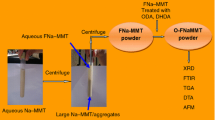Summary
The interaction of sodium decane sulfonate and sodium dodecyl sulfate with sodium and calcium montmorillonite was investigated byx-ray diffraction. Sorption of detergent by clay was calculated from the decrease in detergent concentration and from carbon analysis of the solids.
The two detergents did not interact with sodium montmorillonite either below or above their critical micelle concentrations. Calcium montmorillonite sorbed both detergents, but metathesis, leading to the precipitation of some calcium alkyl sulfate and sulfonate, and hydrolysis of dodecyl sulfate complicated the situation.
Thex-ray patterns of calcium montmorillonite treated with detergent solutions and dried contained two sets of (00l) reflections. One, rather broad, belonged to unmodified clay. Like untreated dry clay, its basal spacing increased by 6 Å on exposure to 85% relative humidity, owing to insertion of two monolayers of water between adjacent clay lamellae. The other set consisted of narrow reflections; their basal spacing, which did not increase on exposure to 85% relative humidity, exceeded that of unmodified clay by a distance equal to the extended length of the C10H21SO3- and C12H25OSO3-anions, respectively. Therefore, the sorbed, intercalated detergent molecules were fully extended, with their chain axis perpendicular to the plane of the clay lamellae.
Sorption may have occurred in two steps: (1) binding of alkyl sulfonate and sulfate anions by calcium counterions of the clay, followed by (2) sorption of sodium alkyl sulfonate and sulfate molecules by association between their hydrocarbon tails and those of previously sorbed detergent anions throughvan der Waals forces.
Zusammenfassung
Die Aufnahme von Natriumdecylsulfonat und Natriumdodecylsulfat in Natrium- und Calcium-Montmorillonit wurde durch Analyse der Gleichgewichtslösungen und der Bodenkörper untersucht. Aus röntgenographisch bestimmten Schichtabständen wurde auf die Anordnung der Detergentienmoleküle im Schichtzwischenraum geschlossen.
Similar content being viewed by others
References
Jordan, J. W., J. Phys. Colloid Chem.53, 294 (1949) and54, 1196 (1950).
Foster, W. R. andJ. M. Waite, Symposium on “Chemistry in the Exploration and Production of Petroleum” A.C.S. Division of Petroleum Chemistry, Dallas, Texas, April 1956, p. 39–44.
Schott, H., Kolloid-Z. u. Z. Polymere199, 158 (1964).
Schott, H., J. Phys. Chem.70, 2966 (1966).
Barr, T., J. Oliver andW. V. Stubbings, J. Soc. Chem. Ind.67, 45 (1948).
Brown, G., “TheX-Ray Identification and Crystal Structures of Clay Minerals”, Mineralogical Society (London 1961).
Kung, H. C. andE. D. Goddard, J. Phys. Chem.67, 1965 (1963).
Vold, R. D. andN. H. Sivaramakrishnan, J. Phys. Chem.62, 984 (1958).
Author information
Authors and Affiliations
Additional information
With 5 tables
Rights and permissions
About this article
Cite this article
Schott, H. On the interaction of anionic detergents and montmorillonite clays. Kolloid-Z.u.Z.Polymere 219, 42–48 (1967). https://doi.org/10.1007/BF02086094
Received:
Issue Date:
DOI: https://doi.org/10.1007/BF02086094




